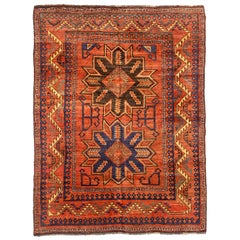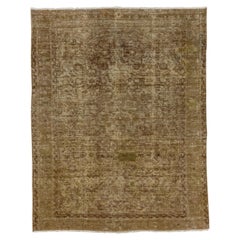Renaissance Revival Russian and Scandinavian Rugs
1
to
1
1
1
1
1,556
541
441
43
27
24
15
3
3
2
1
1
1
1
Width
to
Length
to
1
1
1
Style: Renaissance Revival
1920s Antique Floral Design Part Silk Needlework Rug
Located in Los Angeles, US
Needlepoint rugs were created using the traditional needlework weaving technique that is used to make everyday items from furniture to carpets and artwork. However, it has a fascinating history both as a hobby and as an industry. When many people think of carpets, they think of pile carpets or flat weave kilims, but needlepoint has also been used to create beautiful carpets. These carpets are durable and an important part of carpet history.
Archaeologists and scholars consider the roots of needlepoint to have been around 1500 BC. They consider the first needlepoint to include the fine diagonal stitches that were used to sew tents together by the ancient Egyptians. The art eventually evolved into tapestry weaving. However, a tapestry weaving differs significantly from needlepoint in that it uses a loom and vertical warp.
Tapestry weaving is closer to the weaving of kilims and pile rugs than canvas work. However, some still include tapestry weaving in the category of needlepoint because of the fine work that appeared during the late Renaissance. It can have a similar appearance to the untrained eye. Technically, tapestry weaving and needlepoint are not the same, and they do not use the same technique.
The first actual needlepoint rugs and needle-points began to appear in the late Renaissance. Needlepoint is worked by creating stitches on a stiff canvas. The canvas is typically made from jute or linen and is quite durable. Pieces from the Renaissance were used to cover footstools, chairs, pillows, bed headboards, and other furnishings. They were also used as table coverings and wall coverings. You could also find them on many small items such as purses, shoes, and various adornments for clothing.
During the Renaissance, the craft reached a high level of skill, and the designs became incredibly detailed and realistic. They mimicked many of the subjects and styles of famous paintings of the time. They created florals, still life designs, scenes, and geometric tiled pieces. Some of them mimicked the designs found in Persian Carpets.
Needlepoint reached its peak popularity in the 19th century when it was considered a proper occupation for a lady. Needlepoint and embroidery held a similar place in societal status at the time. During this time, the work became finer, with some of the canvas reaching a high level of detail. The level of detail is determined by counting the number of mesh in an inch. During this time petit point by French needlewomen could have a mesh count as high as 45 mesh. This allowed women to create highly intricate designs with incredible levels of detail.
It is possible to find many antique pieces of needlepoint besides rugs. Needlepoint rugs were popular in France and Spain, where the technique was adapted to create highly intricate designs that mimicked the designs in architecture and fashion. They were popular because they were durable, and it could be fashioned into a variety of items. The canvases themselves were durable, and the wool that they used was also strong, which means that many of the pieces were able to withstand daily use. We have many artifacts that have survived from this time period.
Needlepoint rugs are important collectibles because they are different from the pile rugs and kilims that are typically found on the market. Needlepoint carpets are special because they take many hours to create, especially larger works. Needlepoint pieces of any type became popular throughout Europe during the 19th century. It is still a popular hobby today, but perhaps one of the most interesting stories is that of the Portuguese needlewomen of Arraiolos.
The story of these women and their beautiful carpets begins in 1492. Needlepoint was a popular occupation in Spain, which had a large population of Moors and Jews. They were an integral part of Spanish culture. However, in 1492, Queen Isabella of Spain issued a proclamation that gave these ethnic groups the order to pack their bags and board ships headed...
Category
1920s Vintage Renaissance Revival Russian and Scandinavian Rugs
Materials
Wool, Silk
Related Items
Antique Russian Area Rug Samarghand Design
Located in Dallas, TX
Antique Russian area rug handwoven from the finest sheep’s wool. It’s colored with all-natural vegetable dyes that are safe for humans and pets...
Category
20th Century Russian Renaissance Revival Russian and Scandinavian Rugs
Materials
Wool
Hamadan Vintage Olive Green Rug Circa 1920s
Located in New York, NY
Overwashed, modern aesthetic, faded olive Hamadan rug (Persian) with beautiful allover field
Category
Early 20th Century Renaissance Revival Russian and Scandinavian Rugs
Materials
Wool
Antique Wool Floral Bessarabian Rug from Romania
Located in West Hollywood, CA
This traditional hand-woven Romanian Bessarabian rug has a shaded dark chocolate overall field with four elegant tonal floral vases radiating angled rosettes and delicate leaves, in ...
Category
Late 19th Century Romanian Antique Renaissance Revival Russian and Scandinavian Rugs
Materials
Wool
Floral Medallion Antique Sarouk Persian Rug Circa 1920
Located in New York, NY
Floral Medallion Antique Sarouk Persian Rug Circa 1920
Category
Early 20th Century Renaissance Revival Russian and Scandinavian Rugs
Materials
Wool
Bold Color Floral Blossom Design Vintage Swedish Floral Pile Rug 4'1" x 6'9"
Located in New York, NY
Vintage Swedish rug, country of origin: Sweden, circa early 20th century. Size: 4 ft 1 in x 6 ft 9 in (1.24 m x 2.06 m).
Category
Early 20th Century Swedish Renaissance Revival Russian and Scandinavian Rugs
Materials
Wool
Antique Russian Area Rug Khotan Design
Located in Dallas, TX
Antique Russian area rug handwoven from the finest sheep’s wool. It’s colored with all-natural vegetable dyes that are safe for humans and pets. It’s a traditional Khotan design hand...
Category
20th Century Russian Renaissance Revival Russian and Scandinavian Rugs
Materials
Wool
Impi Sotavalta Finnish Hand-Woven Lavender and Marigold Geometric Ray Rug, 1920s
Located in Brooklyn, NY
Impi Sotavalta (1885-1943) Finnish hand-woven wool lavender and marigold geometric ray rug, c. 1928, Finland. Gorgeous thick pile. Rare, divine color co...
Category
Early 20th Century Finnish Renaissance Revival Russian and Scandinavian Rugs
Materials
Wool
Antique Russian Area Rug Khotan Design
Located in Dallas, TX
Antique Russian area rug handwoven from the finest sheep’s wool. It’s colored with all-natural vegetable dyes that are safe for humans and pets. It’s a traditional Khotan design hand...
Category
20th Century Russian Renaissance Revival Russian and Scandinavian Rugs
Materials
Wool
Swedish Kilim Cross Motif Design Rug, 1920-1950
Located in Ferrara, IT
This is a semi-antique Swedish kilim woven circa 1920-1950 and it measures 235 X 172 CM. It features a simplistic pattern with geometric cross motifs that...
Category
Early 20th Century Swedish Renaissance Revival Russian and Scandinavian Rugs
Materials
Wool
Antique Russian Area Rug Kazak Design
Located in Dallas, TX
Antique Russian area rug handwoven from the finest sheep’s wool. It’s colored with all-natural vegetable dyes that are safe for humans and pets. It’s a traditional Kazak design handw...
Category
20th Century Russian Renaissance Revival Russian and Scandinavian Rugs
Materials
Wool
Bessarabian Kilim Rug, c.1920s
Located in Savannah, GA
A Bessarabian Kilim rug, circa 1920s.
76 by 117 inches
Category
1920s Moldovan Vintage Renaissance Revival Russian and Scandinavian Rugs
Materials
Wool
Antique Russia Area Rug Karabagh Design
Located in Dallas, TX
Antique Russia area rug handwoven from the finest sheep’s wool. It’s colored with all-natural vegetable dyes that are safe for humans and pets. It’s a traditional Karabagh design han...
Category
20th Century Russian Renaissance Revival Russian and Scandinavian Rugs
Materials
Wool
Renaissance Revival russian and scandinavian rugs for sale on 1stDibs.
Find a broad range of unique Renaissance Revival russian and scandinavian rugs for sale on 1stDibs. Many of these items were first offered in the Early 20th Century, but contemporary artisans have continued to produce works inspired by this style. If you’re looking to add vintage russian and scandinavian rugs created in this style to your space, the works available on 1stDibs include rugs and carpets and other home furnishings, frequently crafted with fabric, silk and other materials. It’s true that these talented designers have at times inspired knockoffs, but our experienced specialists have partnered with only top vetted sellers to offer authentic pieces that come with a buyer protection guarantee. Prices for russian and scandinavian rugs differ depending upon multiple factors, including designer, materials, construction methods, condition and provenance. On 1stDibs, the price for these items starts at $19,500 and tops out at $19,500 while the average work can sell for $19,500.


